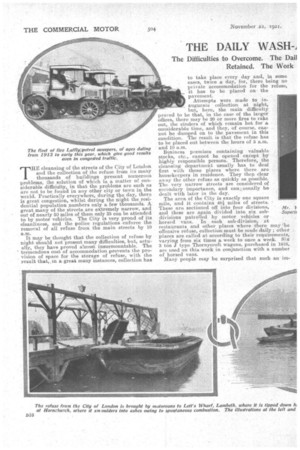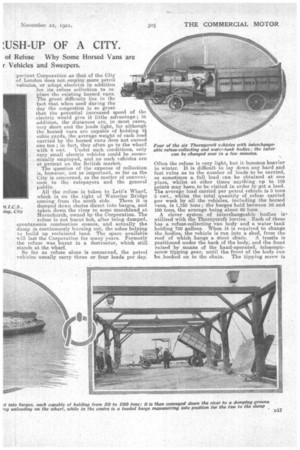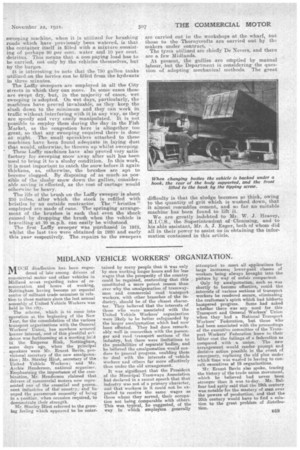THE DAILY WASH-, USH-UP OF A _CITY.
Page 16

Page 17

Page 18

Page 19

If you've noticed an error in this article please click here to report it so we can fix it.
The Difficulties to Overcome. The Dail of Refuse Why Some Horsed Vans are r Vehicles and Sweepers. Retained. The Work
T,HE cleansing of the streets of the City of London and the collection of the refuse from its many thousands of buildings present numerous problems, the solution of which is a matter of considerable diffithilty, in that the problems are such as are not to be found in any other city or town in the weild. Practically everywhere, during the day, there is great congestion, whilst during the night the residential population numbers only a few thousands. A great many of the streets are extremely narrow, and out of nearly 50 miles of them only 35 can be attended to by motor vehicles. The City is very proud of its cleanliness, and the police regulations enforce the removal of all refuse from the main streets by 10 a.m.
It may be thought that the collection of refuse by night should not present many difficulties, but, actually, they have proved ahnost insurmountable. The ' tremendous cost of accommodation prevents the provision of space for the storage of refuse, with the result that,, in a great many instances, collection has to take place every day and, in some
cases, twice a day, for, there being no private accommodation for the refuse, it has to be placed on the pavement.
Attempts were made to inaugurate collection at night, but, here' the main difficulty proved to be that in the case of the larger offices, there may be 20 or more fires to rake out, the cinders of which remain hot for a considerable time, and they, of course, cannot be dumped on to the pavement in this condition. The result is that the refuse has to be placed out between the hours of 5 a.m. and 10 a.m.
Business premises containing valuable storks, etc., cannot be opened except by highly responsible persons. Therefore, the cleansing department usually has to deal first with those places where there are housekeepers in residence. They then clear away the other refuse as quickly as possible. The very narrow streets are considered of secondary importance, and can:,:usually be dealt with later in the. day.
The area of the City is exactly one square mile, and it contains 44 miles of streets. These are sectioned off into four divisions, and these are again divided into six subdivisions patrolled by motor vehicles or horsed vans. In each sub-division, at
restaurants and other places where there may ihe offensive refuse, collection must be made daily ; other places are called at according to their requirements, varying from six times a week to once a week. Six 3 ton j type Thornycroft wagons, purchased in 1916, are used on this work in conjunction with a number of horsed vans.
Many people may be surprised that such an' mm. portant Corporation as that of the City of London does not employ more petrol
vehicles, or adopt electries in addition for its refuse collection to replace the existing horsed vans. The great difficulty lies in the fact that when used during the day the congestion is so great that the potential increased speed of the electric would give it little advantage; in addition, the distances are, in most cases, very short and the loads light, for although the horsed vans are capable of holding cubic yards, the average weight of each load carried by the horsed vans does not exceed one ton ; in fact, they often go to the wharf with 5 ewt. Under such conditions, only very small electric vehicles could be economic.ally employed, and no such vehicles are at present on the British market.
The question of the expense of eollection is, however, not so important, so far as the City is concerned, as the matter of convenience to the ratepayers and the general public.
All the refuse is taken to Lett's Wharf, which is on the right of Waterloo Bridge coming from the south side. There it is dumped down chutes direct into barges, and taken down the river to some marshland at Hornehurch, owned by the Corporation. The refuse is not burnt but, after being dumped, spontaneous combustion ensues, and actually the dump is continuously burning out, the ashes helping to build up reclaimed land. The space available will last the Corporation for many years. Formerly
the refuse was burnt in a destructor, which still
stands at the wharf.
So far as refuse alone is concerned, the petrol vehicles usually carry three or four loads per day. Often the refuse is very light, but it becomes heavier in winter. It is difficult to lay down any hard and fast rules as to the number of loads to be carried, RA sometimes a. full load can be obtained at one place, whilst at other times anything up to 100 points may have.to be visited in order to get a load. The average load carried per petrol vehicle is 3 tons 5 cwt., whilst the total quantity of refuse carried per week by all the vehicles, including the horsed vans, is 1,150 tons; the barges hold between 50 and 100 tens, the average being about 60 tons. A clever system of interchangeable bodies is utilized with the Thornycroft lorries. Each of these has a refuse-collecting van body and a water tank holding 760 gallons. When it is required to change the bodies, the vehicle is run into a shed, from the roof of which hangs a stout chain. A trestle is positioned under the back of the body, and the front raised by means of the hand-operated, telescopicscrew tipping gear, until the front of the body can be .hooked on to the chain. The tipping screw is
then lowered until clear of its clips. The action of raising the front of the body lowers the rear end slightly until it rests on the trestle and is raised clear of its connections on the chassis. The latter is then driven out and backed under the other body, which is supported in the same manner. The tipping screw is engaged with the clips of this body, and, after raising it slightly, it is disengaged from the hook and lowered into position. This operation sounds a lengthy one but, as a matter of fact, it can be performed within a few minutes, and has proved so efficient that, when necessary, the bodies have been changed over twice a day. It is interesting to note that the steam wagons, also of Thornycroft manufacture, were used by the Cleansing Department from 1901 until replaced by the petrol vehicles. During fine summer weather, the Thornyerofts are engaged day and night with but short intervals between the two shifts. During the day they are employed in watering the City streets, whilst at night they spray water over the whole surface before the streets are swept. By day, only the channels of the carriage-ways are watered, partly because most of the dust accumulates in these channels, but chiefly because it would cause inconvenience if the whole width of the street were watered. In those streets which are covered with wood, watering at the channels is rather wider than in the case ef asphalt, as the woad paving is not so slippery whilst, at the same time, it accumulates rather more dust. In the winter, and during wet days in the summer, the lorries are engaged in collecting street and mar ket refuse, in addition to house refuse. In the latter work, the horsed vans are employed when the motor vehicles are being utilized for street watering. Sometimes after heavy rain the streets are clean enough without being watered and brushed, and during long periods of frost it would be dangerous to wash them, as they would become covered with sheets of ice. During these times the lorries are engaged at night in picking up gully refuse. The aVerage daily mileage of the Thornycroft vehicles is 210, i.e., 35 miles each.
For cleansing streets, hosing them at a water pressure of 80 lb. per sq. in. has proved extremely satisfactory, but it cannot be employed to any great extent, owing to the tremendous volume of water required. It is, therefore, confined to such important districts as Billingsgate• and the Central Markets at West Smithfield, where cleanliness is of the utmost importance. In the other districts, the main cleansing operations commence at.8 p.m., when the streets are thoroughly saturated from kerb to kerb by the tank wagon. The water is allowed to stand for half an hour, in order to let it percolate; the streets are then given another slight watering, and the resulting slush is swept to the sides by the Laffiy machines, of which. the corporation owns five. It is suggested by Mr. W. J. Heavey, M.I.C.S., the Superintendent a Cleansing, that a machine should be designed tO follow the sweepers and to pick up the detritus after the water has drained off down the sewers. The difficulty with the container type of sweeping Machine, when it is utilized for brushing roads which have previously been watered, is that the container itself is filled with a mixture consisting of perhaps 90 per cent. water and 10 per cent. detritus. This means that a non-paying load has to be carried, not only by the vehicles themselves, but by the barges.
It is interesting to note that the MO gallon tanks utilized-on the lorries can be filled from the hydrants in three minutes.
The Laffly sweepers, are employed in all the City streets in which they can move.. In some cases these are swept dry, but, in the majority of cases, wet sweeping is adopted. On wet days, particularly, the machines have proved invaluable, as they keep the slush down to tile minimum and they can work in traffic without interfering with it in any way, as they are speedy and very easily manipulated. It is not possible to employ theta during the day in the Fish Market, as the congestion here is altogether too great, so that any sweeping required there is done at night. The small sprinklers attached to these machines have been found adequate in laying dust that would, otherwise, be thrown up whilst sweeping: These Leifly machines have also proved very satisfactory for sweeping snow away after salt has been used to bring it to a slushy condition. In this work, it is most important to catch the snow before it again thickens, as, otherwise, the brushes are apt to becomeclogged. By disposing of as much, as possible of the slushy sinetv down the gullies, considerable saving is effected, as the cost of cartage would otherwise be }wavy.
The life of the brush on the. Lally sweeperis about 230 miles, after which the stock is refilled with bristles by an outside contractor. The "bristles " employed are made of cane. The springing arrangement of the brushes is such that even the shock caused by dropping the brushwhen the vehicle is travelling at 10 m.p:h. can easily be withstood. The first Laffly sweeper was ptirchatied in 1913, whilst the last two were obtained in 1920 and early this year respectively. The repairs to the sweepers are carried out in the workshops at the wharf,. but those to the Thornycrofts are carried out by the makers under contract.
The tyres utilized are chiefly De Nevers, and there are a few Midlands.
At present, the gullies are emptied by manual labour, but the Department is considering the question of adopting mechanical methods. The great difficulty is that the sludge becomes so thick, owing to the quantity of grit which is washed down, that it almost resembles cement, and so far no suitable machine has been found to lift it.
We are greatly indebted to Mr. W. J. Heavey, M.I.C.S., the Superintendent of 'Cleansing, and to his able assistant, Mr. A. S. Eager, both of whom did all in their power to assist us in Obtaining the information contained in this article.








































